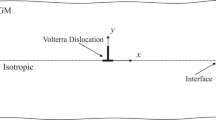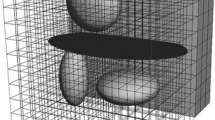Abstract
A numerical method for the integration of the singular integral equation resulting from a surface crack with discontinuous tractions is presented. The crack is modelled as a pile-up of dislocations, and the dislocation density function is partitioned into three terms: A singular term due to the traction discontinuity, a square-root-singular term from the crack tip, and a bounded and continuous residual term. By integrating the singular terms explicitly only a well-behaved residual dislocation density function has to be determined numerically, together with the intensity of the square-root-singular term. The method is applied to the determination of stress intensity factors for a surface crack growing towards, and through, a circular inclusion, and to a surface crack growing into a zone of phase-transformable material.
Similar content being viewed by others
Author information
Authors and Affiliations
Rights and permissions
About this article
Cite this article
Andreasen, J., Karihaloo, B. An accurate method for solving crack problems with discontinuous crack-line tractions. Computational Mechanics 19, 496–500 (1997). https://doi.org/10.1007/s004660050198
Issue Date:
DOI: https://doi.org/10.1007/s004660050198




